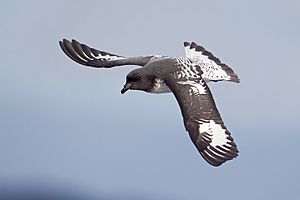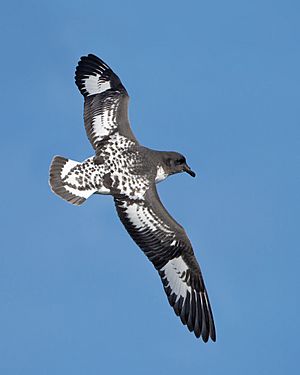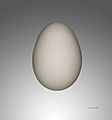Cape petrel facts for kids
Quick facts for kids Cape petrel |
|
|---|---|
 |
|
| D. capense australe south east of Tasmania | |
| Conservation status | |
| Scientific classification | |
| Genus: |
Daption
|
| Species: |
capense
|
| Subspecies | |
|
|
| Synonyms | |
|
Procellaria capensis Linnaeus, 1758 |
|

The Cape petrel (Daption capense) is a common seabird found in the Southern Ocean. People also call it the Cape pigeon, pintado petrel, or Cape fulmar. It belongs to the family Procellariidae. This bird is the only one in its genus Daption. It is related to other petrels like the fulmarine petrels and giant petrels. There are about 2 million Cape petrels, making them very common seabirds.
Contents
About the Cape Petrel
The Cape petrel is the only type of bird in the genus Daption. It is part of the Procellariidae family and the Procellariiformes order. This group includes birds like the giant petrels, Fulmarus species, the Antarctic petrel, and the snow petrel.
All birds in the Procellariiformes order have special features.
- They have nostrils that attach to the top part of their beak. These are called naricorns.
- Their beaks are also unique, made of seven to nine hard plates.
- They can make a special stomach oil in their stomach. This oil is a mix of waxes and fats. They can spray it out of their mouths to protect themselves from animals that want to eat them. It's also a rich food source for their babies and for the adults during long flights.
- They have a salt gland above their nose. This gland helps them remove extra salt from their bodies. They drink a lot of ocean water, so this gland helps them get rid of the salt through their nose.
Different Types of Cape Petrels
There are two main types, or subspecies, of the Cape petrel:
- D. capense capense lives and breeds on islands all around the subantarctic region.
- D. capense australe lives and breeds on New Zealand's subantarctic islands.
What Their Names Mean
The name Daption comes from an Ancient Greek word meaning "little devourer." The "Cape" in their name comes from the place where the first bird of this type was found. The name pintado means "painted" in Spanish, because of their spotted feathers. One of their other names, Cape pigeon, comes from how they peck at the water to find food. The word petrel comes from St. Peter walking on water. This is because petrels look like they are running on the water when they take off.
What They Look Like
The Cape petrel is easy to spot. It has a black head and neck. Its belly and chest are white. The underside of its wings is white with a black edge. Its back and the top of its wings are speckled with black and white. Its tail is also speckled and has a black band. When fully grown, their wings can spread about 86 cm (34 in) wide. They are about 39 cm (15 in) long.
How They Live
What They Eat
Cape petrels mostly eat crustaceans (about 80% of their diet). They also eat fish and squid. Krill are their favorite crustaceans. They catch food by grabbing it from the surface of the water or by diving underwater and filtering it out. They are also known to follow ships to eat food waste and dead animals thrown overboard. When they are eating, they can be aggressive. They will even spit their stomach oil at other birds, even other Cape petrels, to keep them away from food.
Reproduction and Life Cycle
Cape petrels live in groups, called colonies, when they nest. They build their nests on cliffs or flat ground, usually within a kilometer of the ocean. Their colonies are often smaller than those of other petrels. They build their nests with small stones under overhanging rocks or in cracks for protection. In November, the female lays one clear white egg. Both parents take turns sitting on the egg for about 45 days until it hatches. The egg is usually about 53 by 38 mm (2.1 by 1.5 in). Like other fulmars, they will spit stomach oil to protect their nest. Birds like Skuas often try to eat Cape petrel eggs and chicks. After hatching, the chick is kept warm by its parents for ten days until it can control its own body temperature. After that, both parents help feed the chick. The young birds learn to fly, or fledge, after about 45 more days, usually around March.
Where They Live
During the time they are raising their young, Cape petrels feed near Antarctica's coast. In the winter, they travel further north. They can go as far as Angola and the Galápagos Islands. They breed on many islands around Antarctica and the subantarctic islands. Some go as far as the Auckland Islands, the Chatham Islands, and Campbell Island. Their main breeding spots are on the Antarctic Peninsula, South Georgia, the Balleny Islands, the Kerguelen Islands, and islands in the Scotia Sea.
Looking After Cape Petrels
The Cape petrel lives across a very large area, about 146,000,000 square kilometers (56,000,000 sq mi). In 2009, experts estimated there were about 2 million adult birds. Because there are so many of them, the IUCN says they are of least concern. This means they are not currently in danger of disappearing.
Gallery
See also
 In Spanish: Petrel damero para niños
In Spanish: Petrel damero para niños





